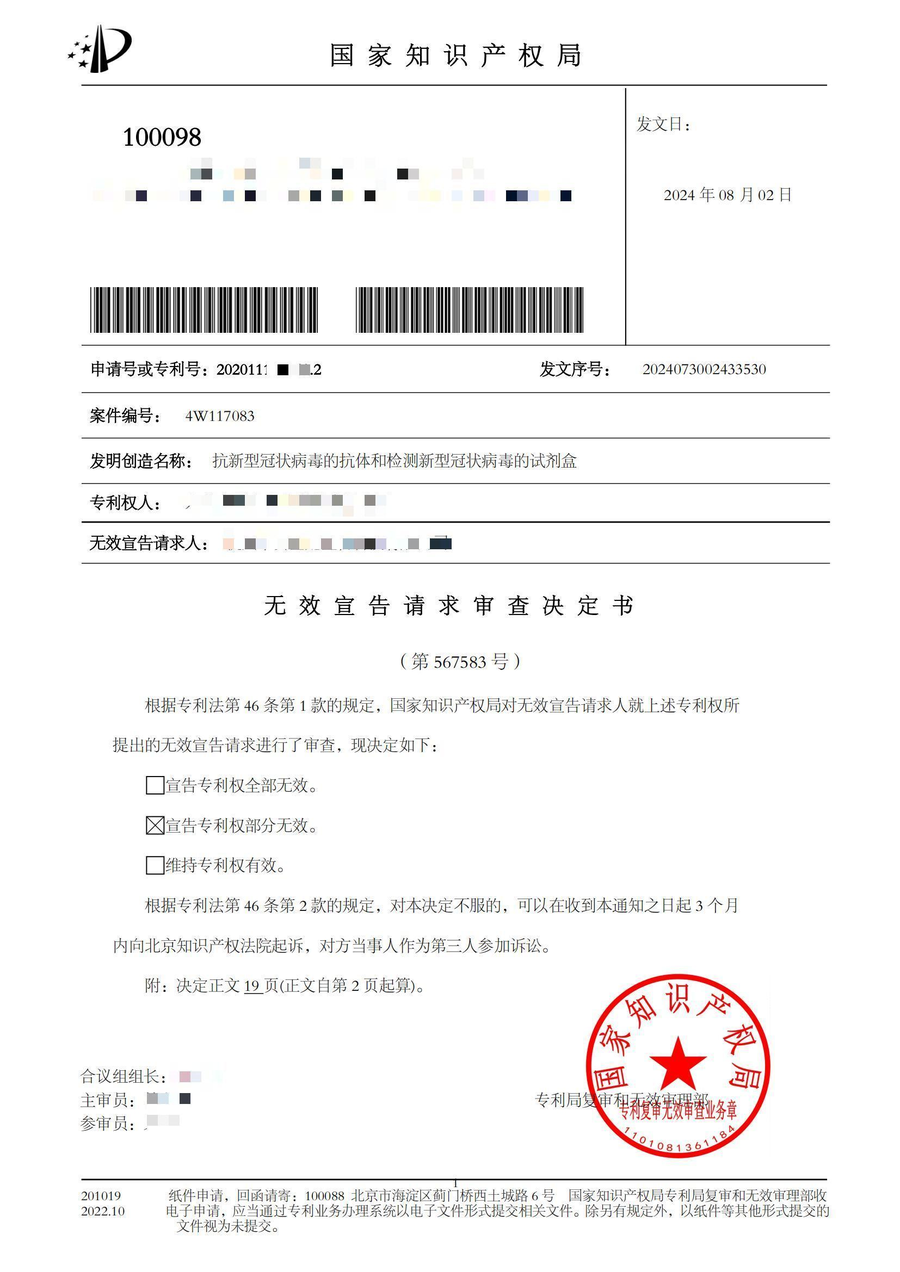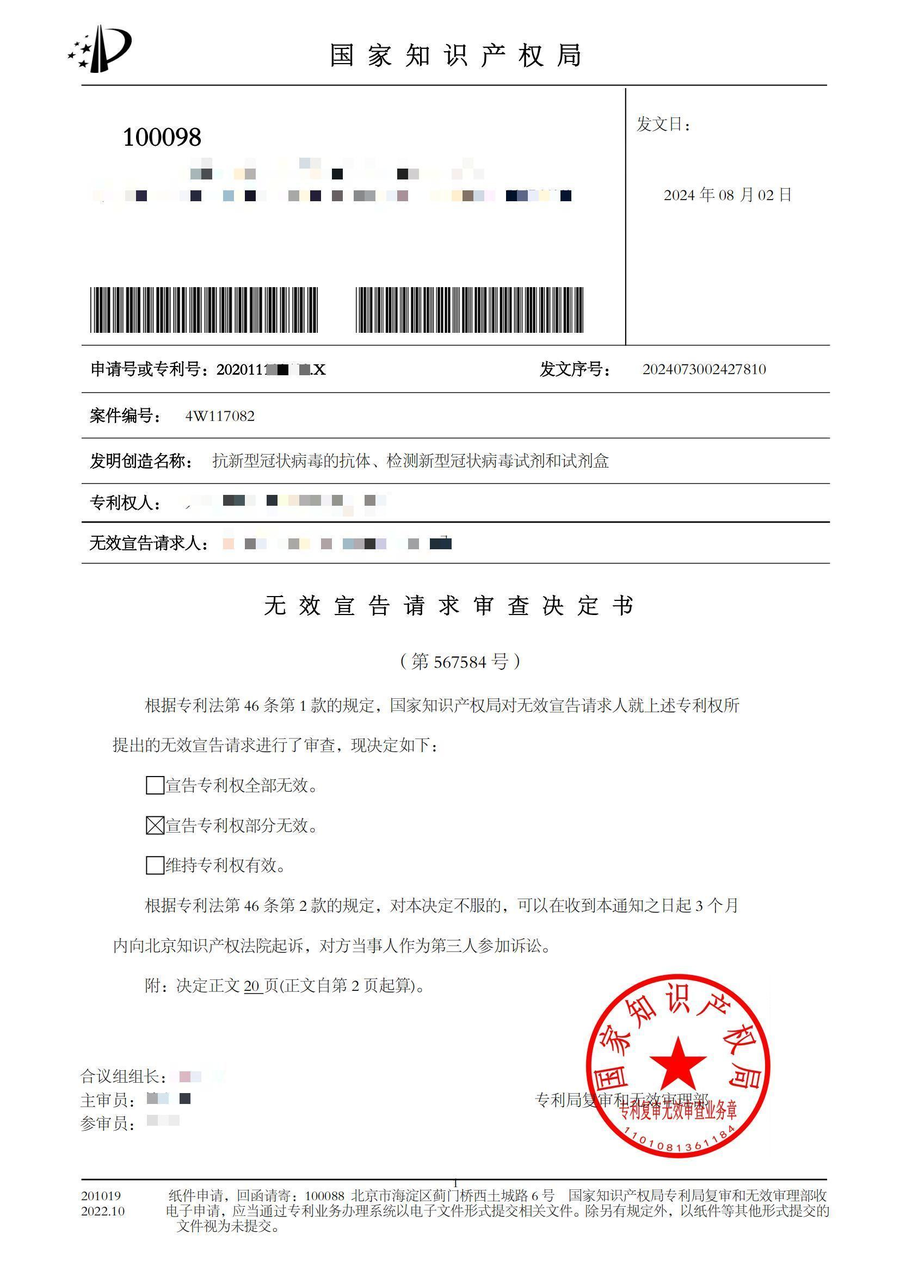Zhifan IP Attorneys Maintains Validity of Two Antibody Patents, Assisting the Client in Rights Protection
Recently, China National Intellectual Property Administration issued the examination decisions Nos. 4W117082 and 4W117083 on request for invalidation, declaring that the disputed patents remain valid. The request was adjudicated and concluded on March 29, 2024. We represented the client and achieved a successful verdict upholding the validity of the patents, laying a solid foundation for the client’s subsequent successful rights protection.
01: Case Introduction
On November 15, 2023, the petitioner filed a request for invalidation declaration against invention patents No. 20201117XXXX.2 (Antibody Against Novel Coronavirus And Kit For Detecting Novel Coronavirus) and No. 20201118XXXX.X (Antibody Against Novel Coronavirus, Reagent For Detecting Novel Coronavirus, And Kit). The patentee entrusted our firm to deal with this invalidation request. We helped the client maintain the validity of the patent rights and won the case!
Since the end of 2019 until the filing date of this application, the pneumonia epidemic caused by the novel coronavirus 2019nCoV has spread globally, posing a severe threat to human life safety and physical health. Respiratory droplet and close contact are main transmission routes of the novel coronavirus pneumonia. In a relatively closed environment, there is a possibility of aerosol transmission when exposed to high-concentration aerosols for a long time. The 2019nCoV is highly contagious. Most infected patients show clinical symptoms, but some are asymptomatic carriers. Common signs of people infected with the coronavirus include respiratory symptoms, fever, cough, shortness of breath, difficulty in breathing, etc. In more severe cases, the infection can lead to pneumonia, severe acute respiratory syndrome, renal failure, and even death. Although there was no specific treatment method for the disease caused by the novel coronavirus at that time, cure rates could be greatly improved and treatment durations could be shortened for mild or asymptomatic patients through treatment. Therefore, it was particularly important to detect or identify patients under such circumstances.
At that time, the main etiological diagnosis evidence for the novel coronavirus 2019 nCoV on the market was nucleic acid testing and viral gene sequencing. Due to influence of various factors such as sampling, operation, and reagents, false negative results could occur in nucleic acid testing. The positive detection rate of viral nucleic acid in highly suspected patients infected with the 2019 novel coronavirus (2019-nCoV) was only 30% to 50%. In addition, nucleic acid testing has high requirements for instruments and equipment, testing sites, and environmental conditions, and thus has disadvantages such as long testing time and low throughput, making it inconvenient for large-scale testing of the population during the epidemic at that time. Therefore, there was an urgent need to develop a rapid and convenient testing kit for clinical testing during the epidemic at that time, so as to isolate the infected individuals as soon as possible to block spread of the virus.
The antibody protected by the disputed patents was developed in such an urgent environment. Specifically, the antibody against the novel coronavirus and the kit for detecting the novel coronavirus were disclosed. The antibody can specifically bind to the N protein of the novel coronavirus with high affinity. Using this antibody to detect the novel coronavirus features good sensitivity and specificity, providing a powerful tool for rapid and convenient detection of the novel coronavirus (2019-nCoV) at that time and isolation of the infected individuals as soon as possible to block the spread of the virus.
The disputed patents are typical antibody patents. The petitioner argued that the patents did not disclose the legal source of the genetic resources on which the patents relied, and thus the claims were rejected under Article 5 of the PRC Patent Law; the claims lacked inventiveness and therefore were rejected under Article 22.3 of the PRC Patent Law; the specifications of the patents did not disclose the contents protected by the claims sufficiently, and therefore were rejected under Article 26.3 of the PRC Patent Law; the protection scope of the claims was unclear and the claims were not based on the specification, and thus the claims were rejected under Article 26.4 of the PRC Patent Law; the claims of the patents lacked essential technical features and therefore were not in conformity with the provision of Rule 20.2 of the Implementing Regulations of the PRC Patent Law.
02: Key Points of the Judgment
Genetic resources referred to in the PRC Patent Law mean materials, taken from human beings, animals, plants, or microorganisms, etc., containing genetic functional units and having actual or potential value; an invention relying on the genetic resources referred to in the PRC Patent Law means the invention using genetic functions of the genetic resources. If a biological material can be obtained by means of genetic engineering technology, the invention involving this biological material does not belong to the category of inventions relying on the genetic resources as referred to in the PRC Patent Law.
That those skilled in the related art can implement the invention means that those skilled in the related art can implement the technical solutions of this application based on the contents described in the specification and in combination with the related art, without inventive work, solve the technical problems, and achieve expected effects. If the contents not described in the specification are insufficient to prevent an implementation of the technical solutions in the claims, the specification cannot be deemed as being insufficiently disclosed.
That the claims shall be based on the specification means that the claims shall be supported by the specification. The technical solution claimed by each claim in the claims shall be a technical solution that can be obtained or generalized by those skilled in the related art from the contents fully disclosed in the specification, and shall not go beyond the scope of the specification. If the generalization of the claim contains the content speculated by the applicant, and effects of such content are difficult to determine and evaluate in advance, it should be considered that this generalization goes beyond the scope of the specification. If the technical solution of the claim is an implementation for solving technical problems of the invention that those skilled in the related art can reasonably foresee on the basis of the contents fully disclosed in the specification and based on an existing technical situation related to the invention, the claims can be supported by the specification.
When the claimed technical solution has distinguishing technical features over the closest related art, it should be determined whether the related art gives any motivation to apply the above distinguishing technical features to the closest related art to solve the existing technical problems. If the related art only generally mentions direction or possibility of selection and does not give a relatively clear teaching to select the distinguishing technical features as specific technical means to solve the technical problems, it should be considered that the related art does not give the corresponding technical motivation, and the claimed technical solution is therefore non-obvious overall the related art.
03: Typical Significance
In the invalidation process, accurately assessing the inventiveness of antibodies and determining whether the specifications of the antibody patents are disclosed sufficiently are important steps in improving the winning rate of invalidation cases.
Based on years of experience with inventiveness of antibody patents and sufficient disclosure, our firm’s senior litigation agents conducted an in-depth and logical analysis of the technical solutions of the disputed patents by grasping overall technical solutions and research and development ideas, and fully understanding legal provisions. This ultimately led to successfully maintaining the validity of the disputed patents.
04: Appendixes (First pages of the invalidation decisions of the disputed patents)




Zhifan IP Attorneys
Committed to China's IP ecosystem with end-to-end solutions to international IP world
We cherish all the innovative ideas aimed to make a better life for mankind.
Add:11th Floor, Linghang Tech. Building, No. 68 Zhichun Road, Haidian District, Beijing 100098, CHINA
E-mail:mail@zhifancloud.com(Domestic)
zf@zhifancloud.com(International)

Website

Wechat ID